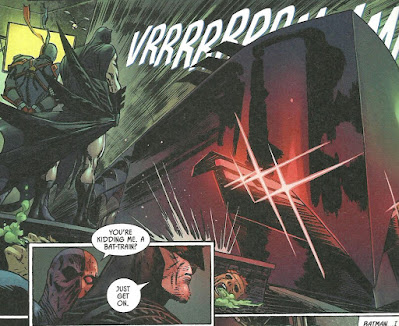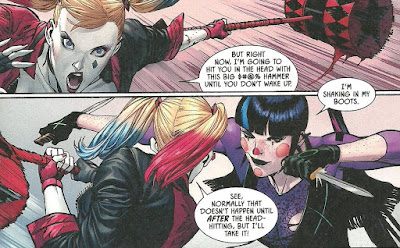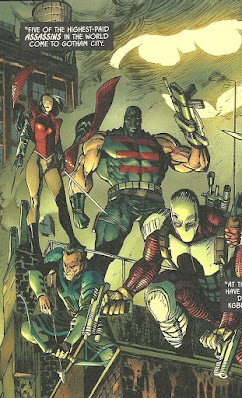I wrote a kinda sorta review of Batman: Their Dark Designs—kinda sorta reviews being my specialty at EDILW!—in the previous post, but I had a lot more to say about it than I had room to do so in that particular format. Although I can't say I had a lot more of any real worth to say about it, as I mostly just noticed a lot of allusions to '90s Batman comics and some buggy continuity. But I thought I'd put it all down in a separate post because why not? If you have a copy of the collection handy, feel free to follow along...!
 |
| Tony S. Daniel and Danny Miki |
1.) Gunsmith, not Gunhawk. When I first saw the above panel, I assumed that Chuck Dixon and Graham Nolan's gun-toting villain with an American flag bandana had gotten a more menacing design update by artist Tony S. Daniel, but this is, in fact, Gunsmith, not Gunhawk, the villain I was thinking of.
Gunhawk was an original creation of the Dixon/Nolan team, and he first appeared in 1994's Detective Comics #674, during Jean-Paul Valley's brief stint as Batman. Gunhawk's costume was sort of mess, pairing green and black spandex with a target-like icon suggestive of Deadshot's, a visor like Cyclops' and, most memorably for me, an American flag bandana worn over his head. He had a partner/girlfriend named—sigh—Gunbunny.
 |
| Kelley Jones |
As minor a character as he is, you may have run into him lately, as I have. He returned in 'Tec #708-#710, "The Death Lottery," a story arc that was recently collected in Batman: Knight Out (reviewed in the previous post). He also appeared during Dixon and Nolan's 2017 maxiseries Bane: Conquest.
Gunsmith appeared for the first time in Batman #85, making him one of several original characters that writer James Tynion IV and company introduce in "Their Dark Designs" (along with Mr. Teeth, The Underbroker and, of course, The Designer).
Like Gunhawk, Gunsmith seems to be another generic-ish mercenary, a former member of the U.S. military turned killer-for-hire. But Batman Secret Files #3, collected in Batman: Their Dark Designs, features an eight-page story by writer Dan Watters and artist John Paul Leon that fleshes the character out a bit.
 |
| John Paul Leon |
It doesn't take up much space, all of two panels, but that there's enough to make the character into an individual character with a gimmick of sorts, and that's enough to make him a decent Batman villain. And a better one than Gunhawk, I would say, but 'hawk still has more appearances to his name. I guess we'll see if any other creators choose to use Gunsmith, or if Tynion himself chooses to return to him. Certainly the character's association with guns, not just the fact that he uses them but that he likes, thinks and talks about them so much, makes him an interesting foil for Batman. At least he was for those eight pages of Batman Secret Files #3.
 |
| Daniel and Miki |
2.) "The movie is insane and so epic and is probably rated R...There's one scene where Batman drops an F-Bomb." The above panel follows five panels in which Deathstroke and Batman fight, the former talking the entire time. Since Tynion wrote a grawlix, we can assume that Batman did not say "Shut the hell up and fight me," as "hell" and "damn" are the swear words Batman uses the most often, and are A-OK to print in DC's DC Universe, Rated T-for-Teen comics. "Shut the hell up and fight me" is the most natural-sounding thing Batman could say in that panel, by the way.
No, since it's a grawlix, it has to be a stronger word than "hell" or "damn" (not that "Shut the damn up and fight me" makes sense anyway). And since "Shut the shit up" doesn't make sense, I guess we can only assume that Batman said "Shut the fuck up and fight me," which, damn, that doesn't sound like something Batman would say, does it...?
 |
| Daniel and Miki |
We see the bowels of the new vehicle under construction, and an ominous bat shape that Fox calls "a bit terrifying," but there's a bit of suspense as to what it actually is. Fox provides some clues during the conversation, when Batman asks if it will do what he needs it to: "It'll run easy enough... It'll be able to scuttle up walls, pounce and track your targets."
That's right, it will scuttle.
Batman refers to the in-progress vehicle as "The Nightclimber," but it's pretty obvious that Tynion, Daniel and company are just introducing The Lego Batman Movie's Scuttler into the DCU for some reason.*
We only see it in action briefly near the climax of Batman #85, the first chapter of the arc, as it scuttles up the side of a building in a sequence that echoes Batman climbing atop a building earlier in the issue, and it then transforms into a bat-plane and takes off; it will spend the rest of the arc in this bat-plane mode. There are a couple of story reasons why a new vehicle is introduced, including demonstrating Batman's abilities as a designer who is always creating new things, to illustrate the role faith plays in his mission, and to give him something to collaborate with Fox on, but the main reason seems to be that Tynion thought The Scuttler was pretty cool. He just didn't like the name.
 |
| Guillem March |
It seems to me, though, that what really keeps Batman from killing people is luck as much as anything else. I mean, he's a big guy, he's decked out head-to-toe in body armor, and dude is always dropping on top of people, flying kicking them, throwing them around, punching them with his gauntlets, throwing pieces of sharp metal at their heads...statistically speaking, it seems like Batman would almost have to accidentally break someone's neck or fracture a skull every couple of months, you know?
This arc contains a particularly egregious example, in which the only thing that spares his opponent would seem to be that the writer decided she she shouldn't die from her injuries.
Batman gives chase to the assassin Cheshire on some sort of crazy urban luge that he ejects out of The Scuttler Nightclimber, rides down the sheer face of a sky scraper and than pilots along the city streets, pursuing her motorcycle. She eventually decides to backflip off of her bike, land high-heels first onto his chest and stick her poison-tipped finger nails into the sides of his face.
When she asks if he has any last words, he replies, "Brace yourself," and steers her directly into an oncoming semi.
The assassin survives being hit by a truck that had to be driving at least 35 miles an hour one way, while she sped at it spine-first at God-knows-how-many-miles an hour the Bat-Street Luge travels. It doesn't even knock her out! She's scuffed up pretty good, and is bleeding from the nose and mouth after getting hit by a truck, but she's still talking to Batman afterwards.
That Cheshire is one tough broad, apparently.
 |
| March |
The character has so long been portrayed as a more-or-less legitimate business man style realistic gangster, one who poses as a nightclub owner while committing more mundane crimes like arms-dealing, blackmail and gun-running, as opposed to the sorts of spectacular terrorist attacks that the various Arkham inmate villains so regularly engage in (or the bird-themed crime that he used to engage in so regularly before the 1990s).
I think that makes The Penguin one of the more interesting of the main Batman villains, and I personally find him a bit more fascinating than others in that he's one of the oldest and greatest Batman villains, but, if we can assign the fictional character motivations of his own, he seems to have intentionally chosen to be a B-grade villain and just settle for making a lot of money, rather than destroying Gotham City, killing Batman or ruling the world like The Joker, Ra's Al Ghul, Bane, Two-Face, The Scarecrow and even The Riddler (who's had an interesting career path over the last 30 years, having both retired and gone straight).
In fact, it's so him to do any sort of "hands-on" villainy that when he does engage in it, it can be presented as something of an occasion. I'm thinking of Doug Moench, Kelley Jones and John Beatty's 1997 Batman #548 and #549, for example, or the point in Batman Eternal where he decides to take fighting a rival into his own hands, regardless of legal peril it puts him in.
 |
| Jones |
Anyway, March's imagery of a Penguin with an entire arsenal of gimmick umbrellas strapped on his back, attacking and kidnapping a team of the world's deadliest assassins lead by Deathstroke, The Terminator is at once awesome and ridiculous, and manages to show the character in a particularly bad-ass light.
I like The Penguin that is too clever to do crazy shit all the time and has to plea insanity to stay out of the electric chair or keep a needle out of his arm (or however they perform capital punishment in whatever state Gotham City is in), but I also like that he's not afraid to pick up a bumbershooter and mix it up with the likes of Batman or Deathstroke every once in a great while.
 |
| Jorge Jimenez |
It...almost kinda sorta works, but it seems a bit much, and I think there's too much tension between the mask and the clothes, what the character does (design crimes) and what he looks like (a modern riff on Marvel's Baron Zemo). Much of his costume looks like what one might expect The General to wear when he grew up.
Now, I'm not sure what the character should look like, as he's presented as something of a cypher character, an archetype with no real personality, history or weight. He's a villain we know nothing about who fights a hero we know nothing about, a character who enters this narrative as a sort of urban legend-come-to-life, a bogeyman character that Gotham's villains swap stories about, and he is here mainly to design a perfect crime spree involving four of Batman's greatest villains.
In that regard, perhaps the military accessories make sense, to the extent that "military" evokes "strategy", but I don't know, it just felt a bit messy to me. And again, the dude's name is "The Designer"; I know he designs crimes not costumes, but I really expect a villain with a name like that to be one of the better-dressed villains, you know...?
 |
| Jimenez |
Dick is shown wearing his New 52 Robin costume, which would seem to orient this post-Flashpoint, during the New 52 timeline...which Death Metal and its various continuity rejiggering follow-ups seems to be radically revising anyway (The artists should probably not commit to a particular Robin costume then, but simply dray him in silhouette with an "R" symbol, to keep the imagery canonical as DC's history shifts so much around stories like this).
While The Joker, Riddler and Penguin costumes are all more-or-less timeless, being basically just suits you could have customized by any Gotham tailor with sufficiently colorful fabric on hand, Catwoman is wearing the purple costume she wore during the first volume of her own ongoing series, launched in 1993. So she's outfitted as she would have been around Year Nine or Year Ten of the pre-Flashpoint timeline (If this were set around Year Three of that timeline, she should be wearing a costume similar to that in Batman: The Long Halloween or Dark Victory).
However, in the (terrible) "War of Jokes and Riddles" story arc of Tom King's Batman run, also set closer to The New 52's Year One, Catwoman was similarly attired, so while her early '90s costume will evoke a relatively late period in Batman history to anyone whose been reading these dang things or a couple of decades (and/or keeps up with the trades), it seems that at least she's been wearing the wrong costume consistently, and that is her post-Flashpoint "Year One" costume. (And I have to assume this story is catering to readers who have been reading Batman comics for a few decades, otherwise Tynion's allusions would be more like appropriations.)
Just as it might have been better not to draw Robin with a costume marrying the panel to a particular continuity if things are in the process of shifting, maybe they should have given Catwoman either a brand-new costume (she does change costumes a lot), or some sort of hybrid one, like the won she wore in Batman/Catwoman: Trail of The Gun**, which fused her early, gray color scheme and her '80s costume's tail with the basic design of the purple '90s costume
 |
| March |
Like most of the new vehicles and gadgets that appear in this arc, the Bat-Train, as Deathstroke calls it, doesn't get much panel-time, and we only see one real exterior shot of it and one interior shot, as the pair take it to The Riddler's location.
This isn't the first time Batman has had his own special form of rail travel, of course. 1993's Detective Comics #667, by Chuck Dixon and Graham Nolan, introduced the Bat-Subway Rocket. The invention of Harold, it was basically a rail-mounted Batmobile that was meant to take the Dark Knight directly into the city from the Batcave, using abandoned subway lines and rocket engines.
 |
| Jones didn't put it on the cover, but I'm gonna post his cover anyway. |
As for the Bat-Train, it is bigger, scarier and more intimidating than the blue Subway Rocket, although it's not entirely clear why Batman would need a train-sized form of rail conveyance, rather than the Batmobile-sized Rocket. I guess he's got so many sidekicks and partners now, the Bat-Train would be a good way to get them all from the Batcave to the city...
 |
| March |
 |
| March |
**If you haven't read Trail of The Gun, don't worry about it. I remember liking it okay, but now I can't remember any details at all, so it didn't exactly make a lasting impression. It was drawn by Ethan Van Sciver though, so you definitely don't want to expose yourself to that guy's work.


No comments:
Post a Comment